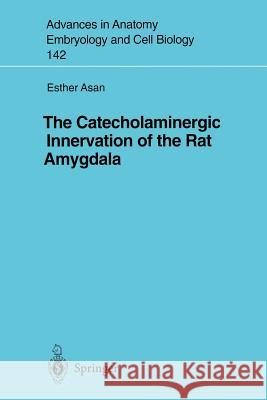The Catecholaminergic Innervation of the Rat Amygdala » książka



The Catecholaminergic Innervation of the Rat Amygdala
ISBN-13: 9783540639039 / Angielski / Miękka / 1998 / 121 str.
The Catecholaminergic Innervation of the Rat Amygdala
ISBN-13: 9783540639039 / Angielski / Miękka / 1998 / 121 str.
(netto: 382,46 VAT: 5%)
Najniższa cena z 30 dni: 385,52
ok. 22 dni roboczych
Dostawa w 2026 r.
Darmowa dostawa!
This text on the catecholaminergic innervation of the rat amygdala covers such topics as: materials and methods; tissue preparation; immunocytochemistry; in situ hybridization; and cytoarchitectonics.
1 Introduction.- 2 Materials and Methods.- 2.1 Tissue Preparation.- 2.1.1 Fixed Tissue.- 2.1.2 Unfixed Tissue.- 2.2 Immunocytochemistry.- 2.2.1 Primary Antisera.- 2.2.2 Specificity Controls for Primary Antisera.- 2.2.3 ICC Procedure for LM Single Labeling.- 2.2.4 ICC for LM Double Labeling.- 2.2.5 ICC for EM.- 2.2.6 Controls for Double Labeling.- 2.2.7 ICC for FM Single and Double Labeling.- 2.2.8 Controls for Fluorescence ICC.- 2.3 In Situ Hybridization.- 2.3.1 Probes.- 2.3.2 Hybridization Conditions.- 2.3.3 Posthybridization Washings.- 2.3.4 AP Detection.- 2.3.5 Probe Specificity Controls.- 2.3.6 ISH on Perfusion-Fixed Tissue.- 2.3.7 ISH on Unfixed Sections.- 3 Results and Discussions.- 3.1 Cytoarchitectonics.- 3.2 Comparative Light, Fluorescence, and Electron-Microscopic Studies of the Morphology and Neurochemistry of Catecholaminergic Afferent Fibers to the Amygdala.- 3.2.1 Introductory Remarks.- 3.2.2 Results.- 3.2.2.1 Distribution and LM Morphology.- 3.2.2.2 Colocalization of Enzyme-Immunoreactivities in Amygdala Axons.- 3.2.2.3 Colocalization of Enzyme-Immunoreactivities in Noradrenergic and Adrenergic Neurons Projecting to the Amygdala.- 3.2.2.4 Double Labeling for LM.- 3.2.2.5 Comparative Electron Microscopy.- 3.2.3 Conclusions for the Identification of Dopaminergic, Noradrenergic, and Adrenergic Structures.- 3.2.3.1 TH, DBH, and PNMT as Markers for Dopaminergic, Noradrenergic and Adrenergic Afferent Fibers of Certain Nuclei.- 3.2.3.2 Identification of Dopaminergic, Noradrenergic, and Adrenergic Afferent Fibers in Nuclei with Combined Innervation.- 3.3 Ultrastructural Features of Neurons and Catecholaminergic Afferent Fibers in the Nucleus Centralis, the Basal Complex, and the Paracapsular Intercalated Cell Groups.- 3.3.1 The Ultrastructure of Neuronal Perikarya.- 3.3.1.1 Central Nucleus.- 3.3.1.2 Basal Complex.- 3.3.1.3 Paracapsular Intercalated Cell Groups.- 3.3.2 Ultrastructural Features of Catecholaminergic Afferent Fibers and of Their Contacts with Target Neurons.- 3.3.2.1 TH-ir Afferent Fibers and Their Targets.- 3.3.2.2 DBH-ir Afferent Fibers and Their Targets.- 3.3.2.3 PNMT-ir Afferent Fibers and Their Targets.- 3.3.3 Discussion.- 3.3.3.1 Comparison of the Ultrastructural Findings with the LM Axon Types.- 3.3.3.2 Comments on the Methodology of Quantitative Analyses.- 3.3.3.3 Dopaminergic Innervation.- 3.3.3.4 Noradrenergic Innervation.- 3.3.3.5 Adrenergic Innervation.- 3.4 Colocalization of Neuropeptides in Catecholaminergic Afferent Fibers to the Amygdala.- 3.4.1 Introductory Remarks.- 3.4.2 Results.- 3.4.2.1 TH/CCK and TH/NT Double Labeling.- 3.4.2.2 DBH/NPY and PNMT/NPY Double Labelings.- 3.4.3 Discussion.- 3.4.3.1 Peptides in Dopaminergic Afferent Fibers.- 3.4.3.2 NPY in Noradrenergic and Adrenergic Afferent Fibers.- 3.5 Neurochemical Characterization of Possible Target Neurons of the Catecholaminergic Amygdala Innervation.- 3.5.1 Introductory Remarks.- 3.5.2 Distribution Patterns of Identified Neurons.- 3.5.2.1 Methodological Considerations.- 3.5.2.2 GABAergic Neurons.- 3.5.2.3 Cholinergic Neurons.- 3.5.2.4 Somatostatinergic Neurons.- 3.5.2.5 Neuropeptide Y Neurons.- 3.5.2.6 Enkephalinergic Neurons.- 3.5.2.7 Neurotensinergic and Corticotropin-Releasing-Factor Neurons.- 3.5.3 Interrelationships Between Catecholaminergic Afferent Fibers and Identified Target Neurons in the Amygdala.- 3.5.3.1 Methodological Considerations.- 3.5.3.2 Results.- 3.5.3.3 Discussion.- 3.5.4 Distribution of Dopaminergic and Adrenergic Receptors in the Amygdala.- 3.5.4.1 Introductory Remarks.- 3.5.4.2 Dopaminergic Receptors.- 3.5.4.3 Adrenergic Receptors.- 4 Summary.- 4.1 Conclusions for the Individual Amygdaloid Nuclei.- 4.1.1 Central Nucleus.- 4.1.2 Basal Complex.- 4.1.3 Intercalated Cell Groups.- 4.2 Conclusions for the Different Types of Catecholaminergic Innervation.- 4.2.1 Dopaminergic Innervation.- 4.2.2 Noradrenergic and Adrenergic Innervation.- Acknowledgments.- 5 References.
Experimental evidence indicated that catecholamines are able to modulate information processing in the amygdaloid complex. The present study provides a detailed documentation of ultrastructural and neurochmical characteristics of dopaminergic, noradrinergic, and adrenergic afferent fibers and of their target structures in central, basal and intercalated amygdaloid nuclei.
Experimental evidence indicates that catecholamines are able to modulate information processing in the amygdaloid complex. The dense catecholaminergic innervation of the amygdala may thus exert significant influence upon its well-documented functions in emotion, attention, learning and memory. Dysfunctions of the systems have been suggested to be involved in the etiology of neuropsychiatric disorders including senile dementia, Parkinson's disease and schizophrenia. To further insight into neural mechanisms of the innervation, the present study provides a detailed documentation of ultrastructural and neurochemical characteristics of dopanminergic, noradrinergic and adrenergic afferent fibers and of their target structures in central, basal and intercalated amygdaloid nuclei. A high degree of heterogeneitiy is observed between the nuclei concerning the different catecholaminergic innervation patterns and the peptide content of individual catecholaminergic fibers, as well as concerning the neurotransmitter/-modulator and receptor expression of possible amygdaloid target neurons. The results are discussed with regard to previously documented properties of the nuclei.
1997-2025 DolnySlask.com Agencja Internetowa
KrainaKsiazek.PL - Księgarnia Internetowa









